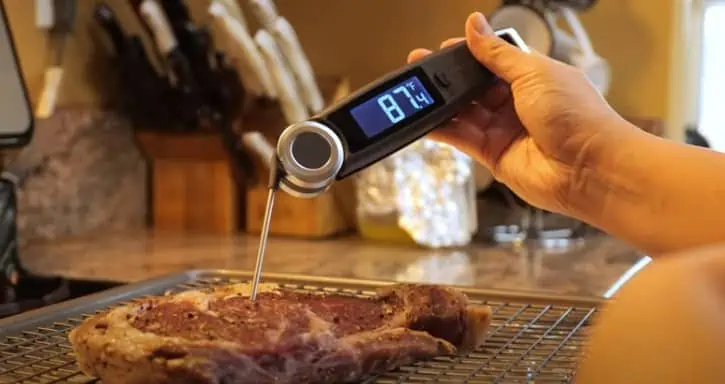How to Properly Use a Meat Thermometer for Juicy BBQ Results
Written By James Morgan
As a barbecue enthusiast, you understand the importance of getting your meat just right. Whether you're grilling, roasting, or smoking, achieving that perfect level of doneness can be a complex task. This is where knowing how to properly use a meat thermometer becomes invaluable. In this article, you'll find everything you need to become a meat thermometer pro.

Why Knowing How to Properly Use a Meat Thermometer Matters
The primary reason for using a meat thermometer is to ensure your meat is both safe to eat and cooked to your desired doneness. Undercooked meat can harbor harmful bacteria, while overcooked meat can become dry and unappetizing. Understanding the correct usage of a meat thermometer takes the guesswork out of grilling and helps you achieve consistently great results.
:max_bytes(150000):strip_icc()/how-to-use-meat-thermometer-GettyImages-1330139635-91da8d92d7ab4711aa195e6f674ed7ac.jpg)
Types of Meat Thermometers
Analog Meat Thermometers
Analog meat thermometers, often called dial thermometers, have a straightforward design and are usually inexpensive. They are best for large cuts of meat that cook slowly, as they can take longer to give an accurate reading compared to digital models.
Digital Meat Thermometers
Digital meat thermometers provide quick and precise readings. They often come with additional features like timers, alarms, and even smartphone connectivity. They are versatile and suitable for a wide range of meats and cooking methods.
Instant-Read Thermometers
As the name suggests, instant-read thermometers provide fast readings, usually within a few seconds. These are ideal for checking the doneness of steaks, chops, and other small cuts of meat. They are also useful for double-checking larger cuts of meat.
Probe Thermometers
Probe thermometers are designed to be inserted into the meat and left there during cooking. These are excellent for slow cooking or smoking, as they allow you to monitor the meat's temperature without having to open the grill or oven, thus maintaining a consistent cooking environment.

Step-by-Step Guide on How to Properly Use a Meat Thermometer
Calibrate Your Thermometer
Before using your meat thermometer, make sure it is calibrated for accuracy. Reset a meat thermometer to ensure that it gives you accurate readings every time.
Insert the Thermometer Correctly
The correct placement of the thermometer is crucial for accurate readings. Insert the thermometer into the thickest part of the meat, avoiding bones, fat, and gristle. Check out our guide on where to place a meat thermometer for more details.
Know the Right Temperatures
Every type of meat has a specific target temperature for different levels of doneness. For example, chicken should be cooked to an internal temperature of 165F, while beef can range from 135F for medium-rare to 160F for well-done. Refer to a reliable source, like the USDA's meat temperature guidelines, to ensure you're cooking your meat to the correct temperature.
Avoid Frequent Checks
Frequently opening the grill or oven to check the meat's temperature can extend the cooking time and affect the final result. Instead, use a probe thermometer that allows continuous monitoring without opening the cooking chamber.

Troubleshooting Common Issues
Inaccurate Readings
If your thermometer is giving inaccurate readings, it might need recalibration. Check the manufacturer's instructions for recalibration guidelines. Regularly checking your thermometer's accuracy can save you from potential food safety issues.
Thermometer Not Holding Calibration
Sometimes, a thermometer may lose its calibration frequently. If this occurs, it might be time to invest in a higher-quality device. A durable, reliable thermometer is a worthwhile investment for any serious barbecue aficionado.
Thermometer Malfunctions
If your thermometer stops working altogether, try replacing the batteries or checking for visible damages. If neither fixes the issue, contact the manufacturer for further assistance.
Advanced Tips for Barbecue Enthusiasts
Using Dual Probe Thermometers
Dual probe thermometers allow you to monitor both the temperature of the meat and the ambient temperature inside the grill or smoker. This can be particularly useful for achieving consistent results with slow-cooked meats.
Utilizing Smartphone Apps
Many modern digital thermometers come with smartphone apps that provide real-time updates and cooking tips. These apps can enhance your grilling experience by offering recipes, doneness guides, and even social features to share your BBQ triumphs with friends.
FAQs
Why is my meat still raw despite the correct temperature?
Ensure that your thermometer is correctly calibrated and placed in the thickest part of the meat, away from bones. If it continues to be an issue, you may need to cook the meat longer to allow heat to penetrate thoroughly.
Can I leave the thermometer in the meat while cooking?
It depends on the type of thermometer. Probe thermometers are designed to stay in the meat while it cooks, whereas instant-read thermometers should be used for quick temperature checks and then removed.
What should I do if I don't have a meat thermometer?
If you don't have a meat thermometer, you can use other methods to check doneness, but these are not as reliable. Learn more about measuring meat doneness without a thermometer.
For more culinary tips, check out this detailed guide from Epicurious.
As an Amazon Associate, I earn from qualifying purchases.



